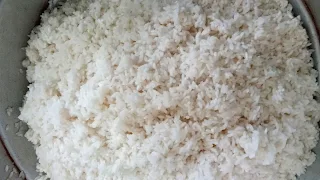MyKitchen: Chicken Biryani
Chicken Biryani
Before lighting the stove
The biryani that I'm talking about here is the one unique to Tamilnadu. People in Tamilnadu like the biryani to be little juicy and not dry like it is prepared elsewhere. Even if you are from other regions, please give it a try. This is one variation which you would like to savor now and then.
There are references to 'ஊன்சோறு' which roughly translates to 'meat rice' in ancient Tamil literature like Silappathigaaram and Puranaanuru.
There are references to 'ஊன்சோறு' which roughly translates to 'meat rice' in ancient Tamil literature like Silappathigaaram and Puranaanuru.
'ஊன்சோறு'was always prepared and served after a victory to mark the celebration. The tradition of 'ஊன்சோறு' was discontinued, but got revived in a different form after Biryani was introduced to India.
But still the Biryani of Tamilnadu stands out from others by the following characteristics
1) Small grain rice is used, since a rice grain without any flavor on its own is preferred. The rice has to soak all the flavors of the masala and meat. Basmati is not preferred
2) The rice is boiled along with the meat and the masala. (not boiled seperately and mixed with the masala)
3) An overpowering flavor of ginger and garlic is preferred
4) Not too spicy but the heat should hit your taste buds in a subtle way
Procuring the ingredients
Another very important factor that influences the taste of a biryani is the volume! That's why we always find the ones prepared at shops more tasty. Believe me! There is a minimum volume that you have to prepare. It is detailed in the ingredients section.
The meat has to be tender, a chewy draggy meat is not the one you want to experience while enjoying a biryani.
I always prefer Godrej Real Good chicken or Suguna Daily fresh from the authorized outlets of Suguna.
If you can't get those the alternates are
1) chose a chicken which weighs around 1kg after dressing
2) buy only the leg, thigh and wing pieces. Let go of the breast. The meat sticking to the bones are relatively tender
Use freshly ground ginger garlic paste. Do not use the ready to use ones, they have a overpowering flavor of vinegar.
Ingredients
Seeraga Samba Rice 1 kg (small grain rice)
Chicken 2 kg (minimum 1.5 kgs. Ask the butcher to cut it into large chunks)
Onion 100 gms (cut lengthwise. Use a sharp knife slice it to 2mm thickness)
Tomato 100 gms (cut into rough chunks)
Ginger 50 gms (normally recipes suggest 100 gm. To make it subtle I recommend 50)
Garlic 50 gms (normally recipes suggest 100 gm. To make it subtle I recommend 50)
Green Chilli 4
Coriander leaves 1 handfull
Mint leaves 1 handfull (don't add too much mint, it would spoil the flavor)
Cinnamon 2 pieces one inch each
Cloves 6 nos
Cardanom 2 nos
Mace 1 whole (its the covering of the nutmeg seed. Jaadhipathri)
Chilli powder 2 heaped tablespoons
Coriander powder 1/2 tablespoon
Curd 200 ml
Oil 200 ml
Water 8.5 (850 ml cups after discounting 200 ml of curd and 50 ml more for water from other ingredients)
Note the size of the chicken pieces
Preparation
Slow cooking is very critical in preparing a biryani.
Heat oil in a wide mouth thick bottomed utensil. Once the oil is smoking add the cinnamon, clove, cardamom, mace. Once it splutters add the green chillies. Add thinly sliced onions and allow them to brown. The color of the dish would turn pale brown if you brown the onions properly
Once the onion has become brown, add coriander leaves and mint leaves, add ginger garlic paste, chilli powder and coriander powder. Add little water to prevent the masala from burning.
Add tomatoes. Cover and let it cook for few minutes. Wash the chicken drain the water and add it.
Add the curd. Add salt (coarse). Cover and cook it in simmer for at-least 15 minutes.
Add water, check for salt and add as required. Squeeze one big lemon. Cover and let it boil
Rinse the rice just in time and drain excess water. Don't soak the rice for long. The consistency of the biryani might become sticky.
The seeraga sampa rice grain absorbs all the flavor in each grain giving a unique flavor.
Once the mixture boils well add rice, stir well, check for salt again and correct as required.
Cover with the lid and put the stove on simmer after 5 mins.
I don't recommend a seal using a wheat dough. Just heat a heavy tawa and place it over the lid.
Leave it for 20 mins in simmer. Switch off the stove and let the biryani settle for another 15 mins
Before serving, mix the biryani with the handle of a spatula. Very few times. You can mix further if required while serving. Ensure that you don't break the grains.
You could smell a flavorful biryani but not overpowering!
Enjoy the hot biryani with onion raitha. Well aged lemon pickle also goes well.
Put the leftover biryani in the freezer and savor it when desired. It tasted better the next day.
Variations
Keep trying subtle variations in the ingredients. I have certain ingredients which I use now and then to give a subtle difference to the flavor.
Like adding few raisins before adding onions or adding two tablespoons of ghee before serving.
Variety in the flavor would always give a feeling like it tastes better. 😋 Surprise with subtle differences.
I do have a secret ingredient that I use rarely! 😉
Have one of yours.
Copyright © 2017 by Kavi Venkatesan
All Rights Reserved
http://www.kavivenkatesan.com/2017/07/copyright.html
All Rights Reserved
http://www.kavivenkatesan.com/2017/07/copyright.html














Comments
Post a Comment